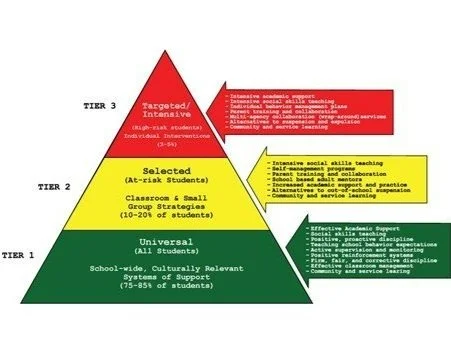Student Support Services | Multi-Tiered Systems of Support (MTSS)
Image provided by Escondido Union High School/Positive Behavioral Interventions and Supports
Multi-Tiered Systems of Support
What are Multi-Tiered Systems of Support? This is a term used to “describe an evidence-based model of schooling that uses data-based problem-solving to integrate academic and behavioral instruction and intervention” (EHUSD, 2022). This definition can be reduced to Tier One: academic support, Tier Two: behavioral support, and tier three: social-emotional learning support. The only adjustment we have to the multi-tiered framework is that we do not particularly categorize students by “risk” labels because narratives are important; we categorize them by risk demographics and/or levels of support needed. Notice there is a difference in saying a high-risk student and a student at high risk of potential outcomes. With that in mind, yes, we believe relationships are foundational to learning, not just with each other but the relationships we have with ourselves, narratives, and language. We also know behavioral and academic needs are a significant part of student needs and actively provide services to meet those needs.
How Do We Fit In?
While we are notably known at OTO to have the #1 SEL facilitator, we use evidence-based strategies in every tier of services we provide. Within tier one, we provide administration, teaching, and support staff training that are culturally relevant and effective. Our training includes classroom management strategies for students with high-risk outcomes. We also unpack how students can be at higher risk due to systemic issues within the education system and society itself. We can then create an equitable foundation for student learning and success by unearthing what ways academia perpetuates harm to particular students. The academic support we provide is not limited to our training but is also throughout our services. All student-centered curricula are academically rooted and aligned with California Health Science Standards.
Tier two is addressed through behavioral supports through behavioral self-regulation-based strategies through every component of the relationship-based curriculum we provide. Behavioral self-regulation is “the ability to act in your long-term best interest, consistent with your deepest values.” It is what allows us to feel one way but act another (Stosny, 2011). Our BVO-YOU mentorship program facilitates this, which provides students with the practices and supports necessary for future orientation, aka long-term best interests. When this mentorship curriculum is implemented, we encourage students to facilitate these conversations with parents, family, or trusted community members. The curriculum itself is also used to support parental and community training and efforts to reinforce student support.
Lastly, tier three has elements that are also supported by tier two, which is something called alternatives to suspension. We are included in what would be termed multi-agency collaboration. We are an organization used in collaboration with school and mental health and wellness services in order to implement, reinforce, or support interventions for students, alternatively to suspension. Alternatives to suspension (ATS) are disciplinary measures or interventions that are implemented prior to suspension or expulsion. There are various reasons that ATS is put in place, including the disproportionate discipline and suspension of Black and Hispanic, and Latino students. Other causes are: suspension is unproductive for student learning, students may not see suspension as a punishment, especially when repetitive, alternatives given prior to suspension are more effective. Some ATS services we provide are alternative programming, mentoring services, community service opportunities, and mini-courses.
Other examples of ATS include on-campus detention or community service, counseling, parent supervision, loss of privileges, mental health services referrals, etc. (Positive Behavioral Interventions and Supports, 2022)
As you know, there are always transformative trends in education. These trends are constantly evolving because we finally recognize the language of harm and trauma that has generationally impacted specific communities. While we know the names of the educational trends and insert all the necessary evidence and research, know that these inner educational workings are things minority communities already knew. Because for many, we have had to find ways to create multi-tiered systems of support in our homes and communities because society never recognized that need after desegregation. This price has usually been paid through martyrdom, struggles, and pats on the back for pulling ourselves and others up by bootstraps. So go off education system. We are grateful that you are catching up. But also, generational trauma teaches in the unseen and far beyond what traditional systems have known. The educational system has just discovered the language and need to catch up.
My Ancestors are were fighters, something I have inherited. - Eric Cantona
Resources:
Escondido Union High School District. (2022). What is MTSS? Retrieved on: March 13, 2022.
Positive Behavioral Interventions and Supports. (2022) Alternatives to Suspension. https://www.pbisworld.com/tier-3/alternatives-to-suspension/ Retrieved on March 10, 2022
Stonsy, S. (2011). Self-Regulation. Retrieved on March 10, 2022

